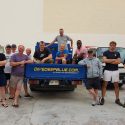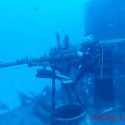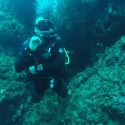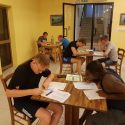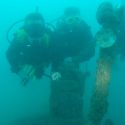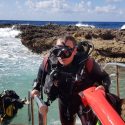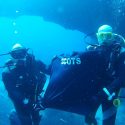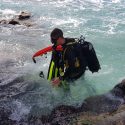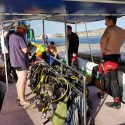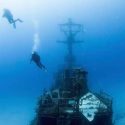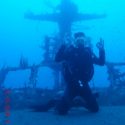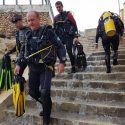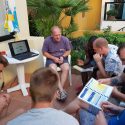7 Scots Diving Trip Malta
22 Oct – 1 Nov 18
Diary by
(LCpl Dickinson, LCpl Wang’oo, Pte Moffat
This report on a Reservist adventure training sub aqua expedition to Malta would still have been in the planning stage were it not for the financial support of the Ulysses Trust to which we extend our sincere thanks.
As a result of the Ulysses Trust support, 11 Reservists from 7Scots (1 from 71 Engrs) and 1 Regular soldier from 1SCOTS conducted a 10-day diving expedition to Malta, based in Buggiba, working out of Dive Deep Blue, a Military Approved Centre. Prior to the deployment, 6 novice divers completed the first level of the British Sub-Aqua Club’s diving course, that of Ocean Diver. 4 Sports Divers also completed some refresher training having only qualified as divers in the 2017 expedition. Training was conducted in the cold waters of the North of Scotland with 1 diver commenting;
“Who dives in these conditions, roll on the warm waters of Malta”
The aim of the expedition was to encourage the personal development of individuals through the adventurous activity of Sub-Aqua. All participants developed their diving knowledge and experience, and for the more experienced gained further BSAC qualifications. Reservists are unlikely to go on operations in the current climate, therefore this expedition enhanced individuals’ confidence, tested personal courage and teamwork, and develop communication and leadership skills which not only benefits the individual but also the Unit.
Monday 22nd October 2018
Having spent the previous night traveling from various company locations and gathering in Perth, we spent the morning of Monday the 22nd October catching an early flight from Glasgow International Airport to Malta International Airport at 0630 hours. Following this we were assigned rooms and proceeded to Dive Deep Blue Centre to prepare our kit for the next day’s dive. As we were unable to dive that day due to having flown that morning, we decided to sort our rations for the week with a quick trip to the supermarket. Due to the lateness of the hour we decided a meal out was in order and spent the evening bonding over a couple of sociable pints and tall tales of deep sea dives courtesy of Captain Ken Scott. (LCpl Dickinson)
Tuesday 23rd October 2018 – Dive Site: Blue Groto
The morning began with a quick breakfast cooked individually in our apartments, followed by us gathering together at 0745 and heading to the dive centre to collect our kit and oxygen. Ken gave us a brief on the mornings dive, showing us various magazines containing information on the wreck and the dive. We headed to the dive site of the sunken HMS Maori located in St. Elmo Bay, which was sunk by a bomb in the early hours of 12/02/1942. However, due to high winds and large swell it was decided that diving here would not be a safe option and therefor quickly headed to a nearby dive site named the Blue Groto. Here we split into two dive groups, were allocated our dive buddies, and after initial dive checks keenly headed to the jump-in point ready for our first dive of the expedition. The Sea state was calm and the site provided an opportunity for members of the group to have a shakeout dive where the cobwebs were quickly brushed away, and diving skills from past experiences were recalled. For the novice members of the group this site provided a fantastic opportunity for one group member to have his first ocean dive, whilst another member was diving outside of Scottish waters for the first time. Everybody in the group managed to complete two dives which were around forty minutes long. The visibility was good and there was plenty of marine life to enjoy and even a few caves to explore with a flashlight. After returning to the dive centre we washed the salt out of our kit and returned to the Accommodation to prepare food and shower. (LCpl Dickinson)
Wednesday 24th October 2018 – Dive Site: Anchor Bay
On this day, we headed to a site named Pop-Eye Village after sorting out kit at the Centre. The road was a dirt track, and the final hundred metres was a steep road down a narrow road with high cliff walls on either side. At the bottom was a pier which had been destroyed by the ocean, and Pop-Eye village, the filming location for the original pop eye film, lay a couple hundred meters away across the bay. Upon diving into the bay, we quickly realised the limitations of the visibility of this dive site, with some divers not able to see more than a meter away. All dive pairs were using a SMB (surface marker buoy) and those standing at the destroyed pier could see just how easy it was to venture too far away from the dive in entry and exit point. This was highlighted when a dive pair ventured so far out to sea that upon surfacing it took them around 10-15 minutes and a great deal of legwork to swim back. Having only completed the one dive due to the murky conditions we headed back, this was my (LCpl Henry Dickinson from C Coy’s) first dive to 20 meters, a dive which I thoroughly enjoyed. We spent the rest of the day undertaking theory lessons in preparation for our Sports Diver’s theory test which we would complete later during the exped. It is extremely vital to learn these valuable pieces of information in order to progress as a diver. (LCpl Dickinson)
Thursday 25th October 2018 – Dive Site: SS Margit
The aim of today’s dive was to practice compass bearing taking us on a bearing of 30degrees for about 100mtrs to the wreck of the SS Margit. SS Margit is a shallow World War II wreck dive in Malta. The SS Margit was a Panamanian steam passenger ship built in 1912. She was sunk in an air raid on 19th April 1941 in Kalkara Creek, on the eastern side of Grand Harbour of Valletta. The visibility was very poor and the wreck is surrounded with very silty seabed which highlighted the importance of buoyancy control. We swam around the wreck and over the top of it before taking a back bearing back to the shore, with the aim to try and get as close to our entry point as we could. On the 2nd dive, we practiced distance line, laying a line under water so that divers can find their way back to the exact start point. Both dives were enjoyable and learned the importance of compass work and laying a line when visibility is very poor. (LCpl Wang’oo)
Friday 26th October 2018 – Dive Site: Lantern Point & P31
Today we drove to Dive Deep Blue as usual, however rather than heading out of the town like we had been doing for the past few days, we drove to the local harbour instead where we were met by a small boat. After packing our kit and fastening it to the railings we headed out in the direction of the country of Malta’s second largest island named Gozo. We weren’t to head to Gozo however, as we instead went to a dive site off the coast of the Island of Comino’s, diving at Lantern Point. It was here that we conducted the first dive of the day, which consisted of great plummeting underwater cliffs, and a rising underwater chimney which some members of the group were able to swim up. The water was clear and the marine life was everywhere. Following a quick stop off at Blue Lagoon for lunch, we headed for a wreck off the coast of Comino named P31. This Maltese navy patrol boat had been scuttled here in 2009 for divers to use, and using a shot line we quickly descended upon the wreck. The wreck stood well in the water, without leaning to one side. Although there were one or two tight squeezes, we could fin around the full inside of the boat which was a fantastic experience. (LCpl Dickinson)
Saturday 27th October 2018
Today we sorted out food in our own apartments then met at reception at 0745. After a quick brief, we then made our way to the dive centre to load up our kit and go over the homework questions we had to answer to make sure we have an understanding of mixes and formulas when planning a dive. We then made our way to Cirkewwa Point which is a popular diving area. It was very busy when we first arrived and got our briefs on what drills and areas we are going to dive. I was in a group with 2 other ocean divers along with Steve who is an advance diver. We all took turns to lead the dives as there where 3 dives to complete today. All dives went well and we saw a statue of the Madonna with a plaque that read “ To commemorate 26th anniversary of the placing of our lady statue by the amphibians diving club” November 2007. We had swam passed it on the first dive as it was tucked into a cave but later found it on the second and third dive. We also saw another plague but that was too far for us as we have not passed our sports divers qualifications at this stage but there was a Gnome village on the sea bed. At a later dive when passed I would like to go back to see what it says and have a look further. We also saw demonstrations on Delayed Surface Marker Buoys (putting a meter-long inflatable tube up to surface by filling it with air and sending it up from the bottom to indicate where divers are), we then practiced it on all the dives we did that day. The whole experience is something else. To be able to go away and view sites you would only think was possible from seeing pictures but to be able to go own and see it yourself is awesome. (Pte Moffat)
The three dives today included exploring the Madonna Statue and few caves at the Cirkewwa diving site, at Paradise Bay in Malta. It was a well-established diving site, good facilities for the divers and very popular. The sea state was very rough particularly at the exit and entry points. The aim of the dive for me and my buddy today was to explore, practice how to deploy Delayed Surface Marker Buoy (DSMB) and simulate deeper diver with Decompression Stops (D.S.) at 9 metres and 6 metres. Overall it was good day of diving with good visibility and plenty marine life to see including a huge octopus. (LCpl Wang’oo)
Sunday 28th October 2018 – Dive Site: HMS Maori
The day begun with the sport divers basic life rescues skills drills at the diving centre pool in Buggiba. We then went to HMS Maori diving site, which was less busy for it being on Sunday and sea state was calm but there was a fairly large swell. HMS Maori was sunk on 19th February 1942. The aim of the two dives were to polish Navigation, practice CBL drills (Casualty Rescue), diving lead skills and enjoy the marine life. Everyone enjoyed the dives, the sport divers getting more chance to plan dives, act as deputy dive manager, doing the briefs and debriefs after each dive and monitoring their dive buddies. The recue was hard due to the swell but showed that you need to think about the end of the dive and getting out which wasn’t easy especially with a casualty.
(LCpl Wang’oo)
Monday 29th October 2018
The dive today was to explore Lighter Water X127 that was built in 1915 and sunk on the 6th March 1942 after an attack by dive bombers and caught fire. The wreck lies on the seabed 6 to 23mtrs deep and about 25m from the stair steps at the harbour. After exploring the wreck and see 2 poppies on the wreck, we practiced two drills at the 10mtrs point; mask clearing and alternative supply, when the diving buddy is having air problems finishing by conducting controlled ascend. After diving, the sport diver’s trainee sat their theory test. It was a successful day and tomorrow we are going to Gozo island for our last expenditure dive. (LCpl Wang’oo)
Tuesday 30th October 2018
On this day we took a ferry to Gozo and drove to a dive site which was unfortunately far too choppy to dive. This consisted of a tunnel from the sea leading to an inland sea which would have been a fantastic dive were the conditions not so extreme. Instead we headed to another dive site on the island of Gozo where we were met by a German woman shouting, upon realising that there was a diver in distress some of the experienced members of the group ran out to what was by that point an unconscious diver which was already slightly beneath the surface. After giving rescue breaths, Ken and three others pulled the diver to shore as fast as they could and we immediately conducted CPR whilst ambulance arrived. After conducting CPR for more than 50 minutes and on the arrival of a Maltese doctor we realised it was futile and instead covered the diver with a sheet whilst other divers on the step (who were now some 20-30 odd) had to squeeze past up the stairs. This incident brought home the dangers of the sport, and the reason behind having CPR and other lessons drilled in both theory and practical. It was only a couple of days before in the pool that we had ourselves been practicing giving the 10 rescue breaths whilst out at sea. We didn’t dive that day due to the incident. (LCpl Wang’oo)
Wednesday 31st October – Dive Site: Cirkewwa Point (P29)
Today was meant to be a day off to visit the war museums and see a bit about the history of Malta. However, because we didn’t dive yesterday we still had 2 dives to do so back to Cirkewwa Point to do some depth progression. Some guys didn’t dive due to medical reasons. P29 was the wreck of the day and although it sits deeper than we are allowed to go, the main deck, gun and mast are all within range. It was a good dive, putting all our drills into practice. We managed 2 dives on that and was a good way to finish off the diving. (Pte Moffat)
Summary
As the 2018 7SCOTS dive expedition draws to a close, it’s time to reflect on what has been an excellent 10 days of diving. 2 people gaining their Ocean Diver qualification, 5 qualifying for their Sports Diver and the 4-remainder gaining further experience at first class dive sites. We must also reflect on the tragic accident of a diver that we assisted, sadly we were too late, our thoughts and prayers are with her family. A huge thanks to our Sub Aqua Diving Supervisor (SADS), Capt Ken Scott and our Advance diver, Capt Steve Dawson who have passed on their experience and knowledge to us all. Thanks, must also go to those outside organisations that supported us financially with a special mention to the Ulysses Trust, without this support these expeditions could not happen. (WO2 Brown)

